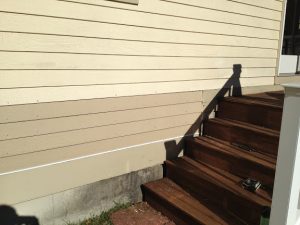Replacing Cracked House Siding when Observed is Necessary for Protecting your Home from Mold, Mildew and Rot
By Mark J. Donovan
|
|
Cracked house siding is a one way ticket for water damaged to your home if left unchecked. It is important to replace cracked house siding as soon as it is observed, to prevent water from seeping in behind the house siding and causing mold, mildew and rot to the sheathing and framing.
The first home I owned had pine wood house siding on it. In less than two years, I began to see curling and cracked house siding.
Consequently I found myself frequently replacing cracked house siding. From this experience I learned a few things about how to prevent and replace cracked house siding.
When installing overlapping house siding clapboards, only one horizontal row of nails should be ideally installed into each clapboard piece.
The nails should be placed such that they only penetrate through the piece of clapboard that is being nailed up. They should not penetrate through the clapboard that it is overlapping.
| For example, if you are overlapping the clapboards by 1.25 inches, the nail should be installed into the top clapboard 1 and 3/8ths inch above the bottom edge of the top house siding clapboard. This nailing technique will allow the house siding clapboard to expand and contract more readily due to changes in temperature. As a result, you should minimize the risk of cracked house siding.
Replacing Cracked House Siding Replacing cracked house siding is a project that most DIY homeowners can perform as long as they own a few basic carpentry tools. |
 |
Replacing cracked house siding is relatively easy to do, however it can be a little tricky removing the cracked house siding while leaving the remaining clapboards in place and undamaged.
To replace a cracked house siding clapboard, begin by carefully cutting the damaged clapboard over a wall stud that is located well beyond the cracked area. Do this by marking the location first with a pencil, and then using a utility knife to repeatedly score the cracked house siding clapboard.
| This process will create a relief line which will help to ensure the cracked house siding breaks along this vertical line when you go to remove it later.
Next use a pry bar to carefully lift up and away from the sheathing the good house siding clapboard that sits above the cracked clapboard. Continue to carefully work the pry bar underneath the good house siding piece to help lift the nails a little. This will create room to slide out the cracked house siding clapboard. Next, work the pry bar up and underneath the bottom section of the cracked house siding clapboard, making sure not to damage the good one that sits below it. |
|
Use a small block of wood for leverage and to protect the lower house siding clapboard.
Once you have slightly lifted the cracked house siding clapboard away from the house sheathing use a hammer to remove the nails from it. You can also use a reciprocating saw to cut the nails on the backside of it if necessary.
After removing the nails, pull the cracked house siding clapboard off of the house, being careful not to damage the other siding pieces in the process.
Install New House Siding Patch
First, check to make sure there is a housing wrap (e.g. Tyvek) behind the area where the cracked house siding existed. There should be one if the house siding was installed correctly. If there is not you should seriously consider installing a housing wrap around the entire house, if and when you ever decide to reside the entire house. The housing wrap is a secondary barrier to the natural elements such as water and wind and should be used on every home construction project.
If there is housing wrap already on the sheathing, use some duct tape to patch up over any tears that may have occurred during the removal of the cracked house siding clapboard.
Also, after removing the cracked house siding piece, make sure there are no nail stubs protruding behind the upper house siding clapboard, as you will be sliding the new house siding clapboard up underneath it. If there are cut nail stubs protruding out from behind the upper clapboard, use your pry bar and hammer to flatten the nails flush with the house sheathing.
Also remove any cut nail stubs associated with the cracked house siding clapboard that was removed.
Next, measure and cut a piece of new house siding.
Prime the new house siding piece on all six sides and put a bead of caulk along the vertical edges of the existing house siding clapboards that will butt up to the new replacement clapboard.
Next, slide the new house siding clapboard up underneath the existing house siding clapboard.
After positioning the new clapboard into place, nail it to the house with hot tipped galvanized nails or stainless steel nails. You will preferably want to use 8D nails so that they penetrate approximately 1.5 inches into the framing studs.
Finally touch up the replaced cracked house siding clapboard with a coat of paint and you’re finished.
Patching Wood Siding Ebook – If you require detailed instructions and pictures for patching wood siding see HomeAdditionPlus.com’s Patching Wood Siding Ebook. This Ebook provides very detailed instructions, along with pictures for each key step in the process of patching wood siding.
Related Information
- How to Clean Wood Siding
- Use Siding Saver Mounting Brackets when Building a Deck
- Why use Building Paper when Siding a House
Get Free Siding Price Quotes with No Obligation!
Fill out our 3-5 minute quick and easy form, and receive a free price quote on home siding from one of our prescreened and licensed siding contractors. This process is free and there is no obligation to continue once you receive your home siding estimate.

